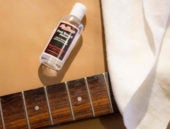Guitarist
-
You probably already spend a lot of time watching YouTube videos, but did you know that YouTube contains a treasure trove of content that can help you become a better guitarist and musician? Whether you’re looking for a tutorial on how to play a song, a walkthrough of a guitar technique, an informative gear review or a vintage lesson, it’s all available on YouTube if you know where to look! Guest blogger Andrei Kryssov breaks it down.
-
If you’ve been playing the guitar for a while now, the standard EADGBE tuning might feel a bit like a musical straitjacket. If you want to go beyond standard tuning however, you’ll need to get off the beaten path. Open tunings open up a whole new world and can make playing guitar feel like an adventure again. “You’re forced to learn how to play guitar from scratch again,” says fingerstyle guitarist Hans Laduc.
-
In this helpful, purpose written guide, Guestblogger Karlynn explains how to replace the scratchplate of an acoustic guitar. Along the way, you’ll also find out why your scratchplate is so important; why it might need replacing at all; how to start, and what you need to watch out for.
-
Unfortunately, there comes a time when everything breaks, and the same is definitely true of music gear, whether it’s speakers, valve amplifiers, or your electric guitar or bass. In the worst case, you’ll need to get it fixed by a professional, but there are some smaller, more simple repairs that you can actually carry out yourself. With a voltmeter, a soldering iron and a little solder on your side, you can get more done than you might think.
-
Whether caused by a bad habit or a passionate performance, the injuries related to being a musician can range from a gradually niggling and continuous beep in one ear, to chronic and unbearable wrist pain. If you want to play comfortably for the rest of your life, then it’s more than worth learning to listen to your body, practise some good-old self care, and avoid long-term injury, hearing damage, and dreaded RSI!
-
Jazz doesn’t just include putting some great techniques under your fingers, but if you really get into it, finding the right guitar for the job can be a nice little journey in itself. Since many different genres sit under the jazz umbrella, some guitars will suit one sub-genre better than another. In this little blog, we talk about the most common jazz guitar models and the jazz genres where you’re most likely to find them. Before we get into it, and for all the beginner jazz-guitarists out there: if you’re looking for your first jazz guitar, the best place to start is by looking at the model that’s in the hands of your hero.
-
The fretboard, or fingerboard, of a stringed-instrument is the surface that the strings are held against to change the pitch and produce different notes and chords, whether you’re playing an electric or acoustic guitar or bass, ukulele, or similar stringed-instrument. Why should you keep your fingerboard clean? How exactly do you clean a fretboard? And what happens if you don’t clean your fretboard? Our Guestblogger, Karylynn explains it all in this handy article and reveals that anyone can clean the fretboard of their instrument, no matter their level of experience, and that the hardest part is removing and replacing the strings.
-
As satisfying as it is to watch your stompbox collection grow, the more crowded your board, the more you need to start thinking about the order of the effect chain, otherwise, there’s a big chance that your sound quality will start to suffer. In this blog, I’ll offer five tips to help you set up your effects pedals in the best possible order and make sure you’re getting nothing but the best possible sound.
-
Whether it’s a single-coil or a humbucker, practically all electric guitar pickups and bass pickups are equipped with a magnet that captures the vibrations of the strings. While magnets don’t boast any sonic properties of their own, the specific type of magnet inside any guitar or bass pickup certainly helps to shape the overall sound of the instrument. Since most pickups feature either an alnico or a ceramic magnet, I’m going to highlight the differences between both and tell you how the well-known Alnico V models compare to Alnico II variants.
-
If you want your acoustic or electric guitar or bass to sound and feel as good as it possibly can, you can’t overlook the importance of proper maintenance. In this article, guest-blogger Dean explains how to nourish your instrument, how to keep the humidity in check and why the right room temperature is crucial.
-
While recording an acoustic guitar might sound like a straightforward job, getting a clear and natural-sounding recording can depend on a number of factors. The kind of microphone you use, the way the microphone is positioned, as well as the way the recording space reacts to the vibration of the strings, all play an important role in the final recording.
-
In this blog, we’re going to talk about playing the blues, show you which ingredients are needed to play typical blues-flavoured sounds on a piano or guitar, and take an in-depth look at blue notes, blues scales, blues-style chord progressions (including that well-known 12-bar blues), straight-versus-swing blues and various other important topics.






















